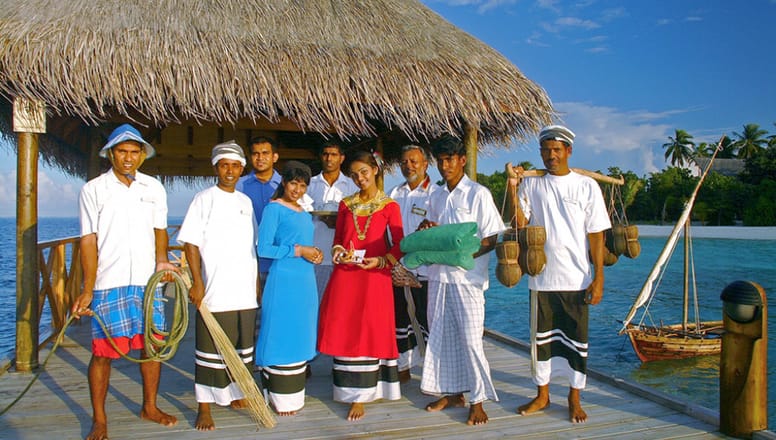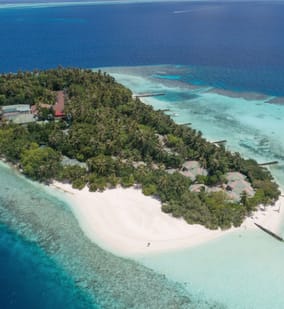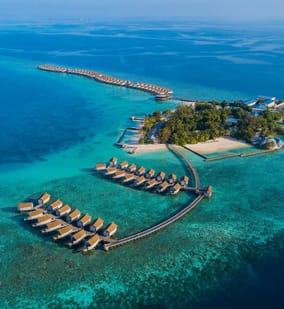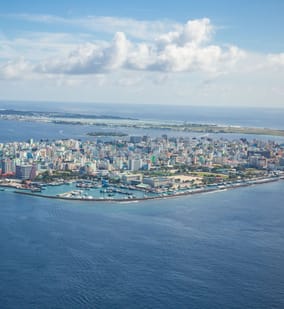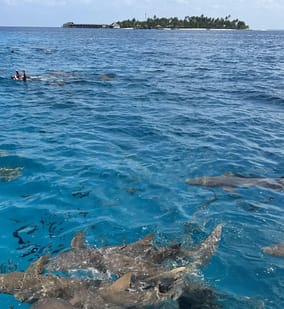The ancient history of the Maldives is a mixture of fact and legend. The Maldives history has been shaped and moulded with the ebb and flow of time and tide.
Throughout ancient times, the Maldives has been influenced by the major civilisations of the world. The Phoenicians, Egyptians and Mesopotamians have passed through the islands during ancient times, each imprinting their influence upon them.
The famous cowry shell from the Maldives once used as currency in different parts of the world has been found in the ruins of the ancient Indus Valley port of Lothal, dating back to 1400 BC. Norwegian adventurer, Thor Heyerdahl the famous archaeologist writes that the Maldives was first settled by sun-worshipping seafarers known as ‘Redhin’, as early as 2500 BC, before Buddhism and later Islam changed the religious landscape of the country.
The Maldives was invaded by Portuguese in 1558 and ruled by them until 1573, continuously raided by Malabars from South West India during the 17TH and 18TH centuries and eventually invaded by them in 1752. Although the Malabar rule was short-lived the raids continued. The Sultans sought protection first from the French at first and then in 1887 signed a protectorate agreement with the British.
Historical Records
Historical records of the Maldives have been found all over the world from Rome to China, in memoirs of Arab and French travellers and as early as the first century AD. In addition to the content of the record, the records themselves help us to fathom the historical links we have had with people and countries the world over.
Ancient chronicles of South India and the Mahavansa of Sri Lanka contain records about the Maldives. Records on the Mahavansa, one of the ships that sailed with Prince Vijaya who went to Sri Lanka in 500 BC, went adrift and landed at an island called Mahiladvipika, which is the Maldives.
A Roman manual of navigation from the first century AD, Periplus Maris Erithraei mentions islands assumed to be the Maldives.
Ptolemy, the famous 2ND century AD Greek astronomer, mathematician and geographer, refers to the Maldives in his Geography.
The first record of Maldivians sailing abroad is obtained from the writings of the Roman soldier and historian Amianus Marcelinus (circa 320-390 AD). He records a visit by a delegation of Divis (Maldivians) to Rome in 362 AD bearing gifts to Emperor Julian.
A historical document of China records that in the years 658 AD and 662 AD, the King of the Maldives sent gifts to the Chinese Emperor Kao-Tsung of the Tang dynasty. The gifts were taken to his court by Maldivians.
According to written records of the Chola Dynasty of South India, the Chola king Raja Raja I (985-1014 AD) captured a number of islands of the Maldives after a naval encounter during the late 10TH or 11TH century AD.
Arab travellers wrote about the Maldives as early as the 900 AD. In 1343 AD Ibn Batuta the famous historian and traveller visited the Maldives, lived here and wrote about the country.
The famous French traveller, Francois Pyrard de Laval, arrived in the Maldives with his ship "Corbin" in the year 1602 AD, during the reign of Kalaafaanu. The writings of Pyrard relate a number of stories and events in the Maldives during that time.
20th Century Chronology
1901: Second scientific expedition to Maldives led by Alexander Agassiz.
1902: King Imadudeen VI leaves Maldives for Egypt to marry the daughter of the Persian (Iranian) consul in Egypt.
1905: Official British visit to Male' for the 'Assumption of the State Sword' ceremony of King Shamsudeen.
1906: Opening of the first post office and regular mail service.
1909: British governor of Ceylon makes official visit to Male'.
1914: At start of war, imported food and other goods increase suddenly in price. Trade in the capital is controlled by Borahs, Indian nationals resident in Male'. Government in Male' sends grain to atolls to alleviate the food shortages.
1917: British military seaplane wrecked near Filitheyo island on Faafu atoll. Pilots rescued by fishing boats from Fieeali and Bileiydhoo islands.
1920: British present King Shamsudeen with the 'Warrant and Insignia of Most Distinguished Order of Saint Michael and Saint George'. Formal presentation ceremony in Male'.
1922: H.C.P. Bell examine Buddhist remains in Gan island, and an old coral rock fort on Hithadhoo.
1928: Government school Madharusathul-Saniyya opens in Male' and now known as Majeedhiyya School.
1930: Japanese survey ship visits Maldives and cruises around the atolls for months.
1931: Population of Maldives is around 80,000.
1932: The 81st Monarch Sultan Mohamed Shamsudeen III proclaims Maldives' first written constitution.
1934: Second constitution proclaimed. It is based on the first 1932 constitution with amendments.
1935: King Hassan Nooradeen is chosen to be king with ceremonial powers only.
1936: Third constitution proclaimed with more amendments.
1940: Rice rationed in Maldives by Hassan Fareed - one cup per person in Male', half cup per person in other islands.
1941: British Royal marines land on Addu atoll to establish secret Port T base.
1942: Royal Marine Engineers arrive on Addu and construct airport on Gan island.
1943: Mohamed Amin assumes power. The National Security Service is set up and fish exports are nationalised.
1947: British give 300,000 pounds sterling. Money is compensation from the Japanese for the families of the victims of the sinking of the Addu ship Yahunbarahu during WW2.
1948: The Maldives saw the issuance of the country’s first legal tender notes.
1950: A passport office was established to issue travel documents.
1952: Electricity available in Male'.
1953: The First Republic was proclaimed with Muhammed Amin as its president but was overthrown in August.
1954: Sultan Muhammed Fareed al Awwal ascended the throne of the Sultanate.
1956: Municipal council formed.
1957: Ibrahim Nasir is elected president. His call for a review of the British occupation of Gan Island leads to three southern atolls temporarily breaking away to form a separate state called United Suvadive Islands.
1958: Roman calendar date system adopted from 1 January.
1960: Hulhule' airport construction begins. Maldives grants the British a 30 year lease of Gan.
1962: Huvadhu atoll divided in half for administration. The break-away atolls become part of the Maldives again.
1963: British agree to return Addu to Male' control.
1964: Women permitted to vote in Maldives. Girl Guides established.
1965: July 26, Maldives attain full independence from the British. Became a member of the United Nations on September 21.
1966: Hulhule airport opens and Air Ceylon flight makes first commercial landing.
1967: The Government hospital is opened with British assistance. Renamed the Central hospital (now known as ADK Hospital). Maldives joins International Telecommunications, International Maritime Organisation, Universal Postal Union.
1968: The Majlis votes in favor of setting up a republic which was then confirmed by a public referendum. Ibrahim Nasir elected as President of the Republic and sworn in on 11 November.
1972: On 16 February the first group of 22 Italian tourists visits the Maldives; 1097 tourists arrive in the year. British queen Elizabeth II visits Maldives.
1974: State Bank of India opens branch in Male'. First bank in Maldives.
1976: British decide to abandon Gan base on Addu atoll, 10 years before their lease expires. State Trading Organisation, STO, established.
1977: Wireless communication, organised by Cable and Wireless, begins from Male'. Enables direct communication between Nasir and Maldives representatives in UN.
1978: Felivaru fish canning factory opened in February as joint venture with Japanese Nippon corporation. Television broadcasts begin in March. Ibrahim Nasir retires on 10 November after completing two terms of office as president. Maumoon Abdul Gayyoom elected as president.
1979: First government primary schools outside Male' opened in Manadhoo island Noonu atoll and Kulhudhuffushi, Haa Dhaal atoll.
1980: Basic Education Project begins in Male'. Later, UNICEF and UNDP fund Atoll Education Centre.
1981: Male’ International Airport is opened. Maldives Monetary Authority established.
1982: Science Education Centre, funded by the UNDP, opens in Male'.
1983: The Maldives is made a special member of the Commonwealth of Nations.
1984: Islamic Centre and Grand Friday mosque, designed by Malaysian architects, opened in Male'. Wood carvings and Arabic calligraphy done by Maldivians.
1987: High waves devastated parts of Male’ and several other islands. Surfacing of roads begins in Male'. International direct dialing services begin in Maldives. Population of Maldives reaches 200,000.
1988: Sri Lankan mercenaries attempt to overthrow the government, apprehended with the help of the Indian military.
1989: National environment action plan developed.
1990: The Maldives celebrates 25 years of independence. Breakwater on south side of Male’ is completed.
1992: Maldives participates in Earth Summit at Rio de Janerio.
1995: Survey carried out on marine protected site on Ari atoll.
1996: Tobacco advertising banned throughout Maldives.
1997: Reclamation of Hulhumale begin to accommodate a growing population of Male'.
1998: Tourism is further expanded with 14 new resorts.
People and Language
Evidence suggests that Maldives has been populated and thriving as early as the 4TH century BC. It is evident that the first settlers were an Indo Aryan race from India and historical records show that although small in numbers, people have migrated from Arabia and eastern Africa.
An anthropological survey carried out at the end of the 19TH century showed the Maldivian inhabitants had traits that revealed ancestral linkages with peoples from all corners of the Indian Ocean. Today, the Maldivians are a mixed race with a population of about 550,000.
Travellers to the Maldives have commented on the Maldivian people as kind and hospitable people, a peaceable race and as a people who are kind to visitors and travellers.
The people of the Maldives are unified by a common history, faith and language. Although the islands are dispersed over a long stretch of ocean, these elements create a common bond that has kept the Maldives unified as a nation for centuries.
Dhivehi is the language of the Maldives. The language has undergone changes as a result of contact with the outside world throughout the centuries, blending with and absorbing new influences as it evolved. Given the wide dispersion of the islands, it is not surprising that the vocabulary and pronunciation vary from atoll to atoll, which is especially significant in the southernmost atolls.
The language displays much resemblance to several other languages from Sri Lanka and rest of Asia. It contains many Arabic, Hindi and English words. Historically the early people spoke "Elu" a form of ancient Singhalese. Many of the Dhivehi words have their root in Sanskrit.
Dhivehi is used in the administration of the country. Until the 1960s, Dhivehi was also the medium of teaching in all schools, but even today Dhivehi is a compulsory subject in the national curriculum. English is widely understood, spoken and written by the locals. Many in the tourist industry are also fluent in other European languages and Japanese.
Maldivian Dress
The Maldives has its own national dresses and costumes that have changed over time. Even today a walk on the streets in Male’ will offer you a mix of the traditional with the modern.
The oldest Maldivian dress is the Libaas which has evolved and changed over time. The Libaas is worn with an underskirt called Feyli. Feyli has traditionally been an important piece of attire for both men and women. It is a black or dark brown wraparound that is bordered at the bottom with broad stripes of white.
Feyli was worn by the nobility as a sarong. The wraparound was also part of the ceremonial dress of the palace guards and other attendants at the palace.
Dhigu Hedhun is a more recent introduction. The national dress was designed and introduced in the 1950s and is now widely worn by ladies as an everyday dress as well as at important national functions.
Folklore
The Maldives is no exception when it comes to legend myth and folklore. There is legend and myth surrounding key event in history such as the arrival of the first settlers to Maldives, the conversion of Islam and the liberation from Portuguese rule in the 16TH century.
There is also a tradition of story telling. Such legends and stories were passed on from generation to generation by word of mouth. Traditional story tellers knew the stories by heart and they presented it with passion and drama.
The story of Dhon Hiyala and Ali Fulhu:
The island of Buruni in Thaa Atoll is the setting of the most famous love story in Maldivian folklore and it is the most popular love story in the Maldives history. The story is a linguistic picture of island life from much earlier time, referring the close relationship between Maldivians and the sea. The worst external threats to the islanders comes from the Kings in Male'.
Dhon Hiyala was a beautiful girl who lived on the island of Buruni in 14TH century. Her father was a toddy tapper, who was also an eloquent reader of the Holy Quran. In recognition of his skill the King elevated Dhon Hiyala’s father from the rank of toddy-tapper to rank of Malin.
Dhon Hiyala meanwhile was in love with Ali Fulhu, a goldsmith from island of Hulhudheli of Dhaalu Atoll. They loved each other dearly and Ali Fulhu gave Dhon Hiyala a lot of beautiful jewellery as a token of the love he felt for her. The blessing and the fortune that the King bestowed on Dhon Hiyala’s family as a result of her father’s achievement turned out to be a curse on Dhon Hiyala.
Dhon Hiyala’s beauty was noticed by the King and he asked Dhon Hiyala’s hand in marriage. Dhon Hiyala refused and the Kings’s agents seized her and took her to the palace in Male'.
Ali Fulhu followed her to Male’. Lost and in total desperation Ali Fulhu rescued his love from the clutches of the evil agents at the palace. They were pursued by the King’s soldiers. The couple decided to jump into the sea rather than fall into the hands of their pursuers.
The story of Rannamaari:
Maldivians embraced Islam in 1153 AD. As expected with such an important event that changed the lives of all Maldivans, there is legend and myth about the events surrounding the conversion to Islam. Ibn Batuta the famous traveller and historian visited and lived in the Maldives in the 14TH century, just over two centuries after the conversion to Islam. He wrote the legend as it was narrated to him by the people at the time.
The people of the islands at the time were idol worshippers and there appeared in Male’ once every month a demon from the sea known as Rannamaari, which resembled a ship full of lamps. To appease the demon the islanders had to take a virgin girl to a temple on the seashore. The unlucky girl is taken to the temple at sunset on the night of the demon’s appearance and left there alone. In the morning the people would find the girl dishonoured and dead.
Every month the islanders drew lots to decide who should go. And the unlucky man on whom the lot fell, sacrificed his daughter for the safety of the community. Once there was a pious traveller from Morocco by the name of Abu al-Barakaath Yusuf al-Barbari who was on a visit to Male’. He was staying with a poor family in the island.
One day when he arrived home he found the family distraught and deeply distressed. He inquired as to the reason why they were crying and was told the story of the evil spirit, that the lot has fallen on their daughter and that she has to be taken to the temple for the sacrifice that night.
Abu al-Barakat comforted the family and said that their daughter need not go. It was he who went to the temple that evening, clad as a girl. The next morning when the islanders went to the temple, to their amazement they found the pious traveller from Morocco sitting there and reciting the holy Quran.
The people took Abu al-Barakat to their king who was told of the extraordinary happenings of the night before. The king was astonished and the Moroccan proposed to him to embrace the true faith of Islam. The king asked him to wait for one more month. The following month on the day of the appearance of the demon Abu al-Barakat went to the temple.
The King and his subjects arrived at the temple the next morning to find him yet again reciting the holy Quran. The people then broke their temples and idols and embraced Islam.
Even after the people converted to Islam the fear of the demon remained embedded in their minds. Ibn Batuta wrote that when he was in Male’, one evening he heard a lot of shouting and crying.
He found out that the people had seen the demon coming from the sea, full of lamps as it was said in the legend. People started praying and reciting the Quran after which the demon disappeared. Note: there are many versions of the story of Rannamaari.

